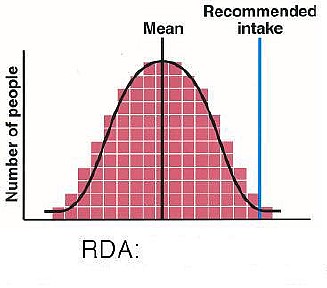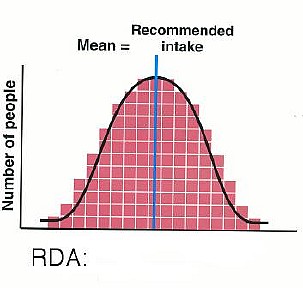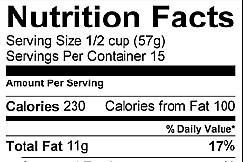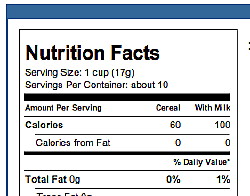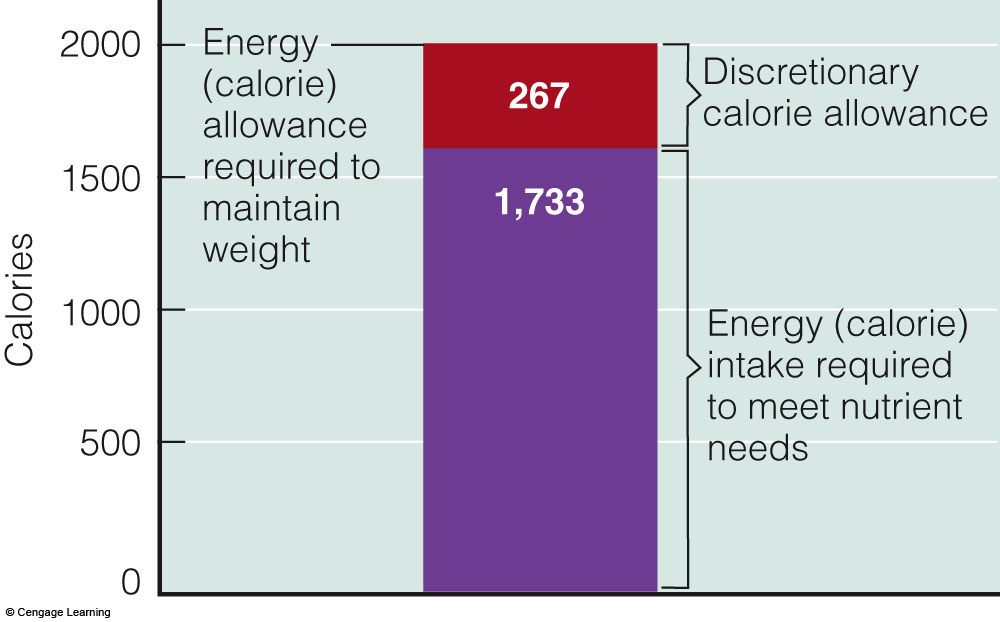|
CORRECTIONS/HIGHLIGHTS/ANNOUNCEMENTS:
This term we will be talking about local foods, and sustainable food choices. I wanted to bring to your attention the Learning Garden we have right here on campus: LEARNING GARDEN EVENTS For more information, e-mail learninggarden@lanecc.edu. For Exam 1 during Week 3, you should study:
|
|||||
FORUM topics for Week 2 I hope you decide to participate. I've
really enjoyed your postings. You've done a
great job at using the forums for asking questions and
helping other students by answering their
questions. Keep this up because most likely
other students can benefit from your questions.
I will post a forum titled, "Questions." Please
post your questions as a REPLY to my posting instead
of creating a new posting. Therefore all the
questions can be found in one place, under my posting
QUESTIONS. These topics will
also be posted for you to discuss Week 2:
|
|||||
|
Chapter 2:
Nutrition Standards & Guidelines
Remember you will be asked a few mystery questions in your Study Questions about your lecture notes. First look through the major headings of this lecture: I (DRI) Dietary Reference Intakes (page a in front of book) II My Pyramid (USDA Food Guide) III Daily Values (DV) (page Y in back of book) IV Dietary Guidelines for Americans, 2005 (Ch. 1, p. 16 of text) V Beyond the nutrients of the twentieth century
You might be thinking this all sounds a little too technical and IT IS! Or you might be thinking well how do I know if my diet is giving me the nutrients I need. How do I know if I'm getting enough calcium or iron. Like I mentioned earlier the RDAs (and the AIs) are usually used in clinical or outpatient settings, where a dietitian might use them to assess an individual's nutrient intake. They also may be used to determine a formula prescription for a tube feeding. You will use them in this class, when you assess your own nutrient intake when you analyze your diet using the mypyramid website. For the most part individual's don't use the RDAs and AI's, because people eat FOODS not NUTRIENTS, so the food guide pyramid is a much more useful guide. That is what we are going to discuss next, but you might need a stretch break first! STRETCH BREAK! II My
Pyramid (USDA Food Guide) Definition- A visual
representation and explanation of a daily food and
activity guide.
It is a food guide to help Americans achieve the goals of the Dietary Guidelines for Americans, as well as meeting the RDAs and AIs or (DRIs). For most people this means eating MORE fruits, vegetables, whole grains, and low fat dairy. And eating LESS of total fats, added sugars, and refined grains. 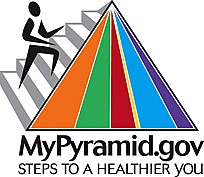 Above is what the Pyramid looks like now and below is what it looked like when it was first released in 1992. 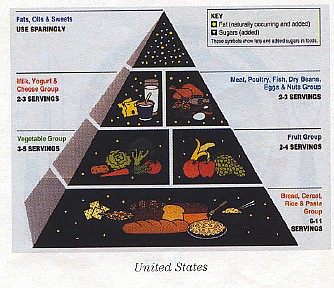 In both, foods are
grouped into 5 different groups, based on their
nutrient content.
Figure
2-5 shows the USDA Food Guide and lists which
nutrients the different food groups contribute to the
diet. If you look at the fruit and vegetable
groups you'll notice they contribute Vitamin A,
Vitamin C, potassium, and fiber to the diet.
Vegetables also contribute Folate (a B vitamin) and
Mangesium (a mineral) to the diet.
There are other food guides in other countries,
some in pyramid shapes, and some in other shapes: 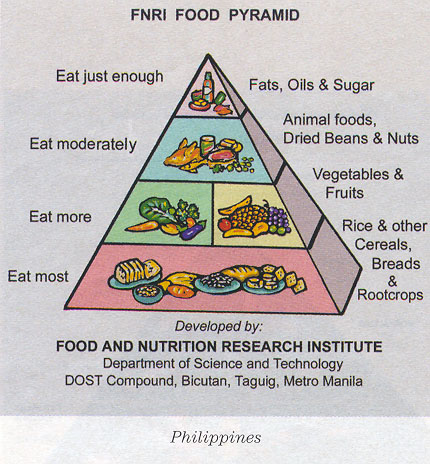 Philippines  Mexico 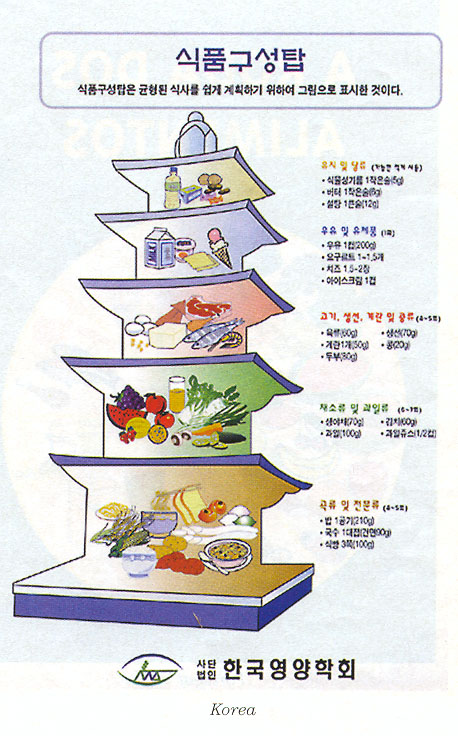 Korea |
The first U.S. Food Guide, shown below, was
released in 1917.  The short video clip below talks about it. |
| Food Guide Video Clip (approximately 2-minutes) |
| History of U.S. food grouping systems: about 1917- 5 groups WWII to 1955- Basic 7 1956 - 1992- Basic 4 1992- Food Guide Pyramid (not tested on these
dates)
Below are the Basic Four Food Groups and below that
the Basic 7 that were still around in 1950.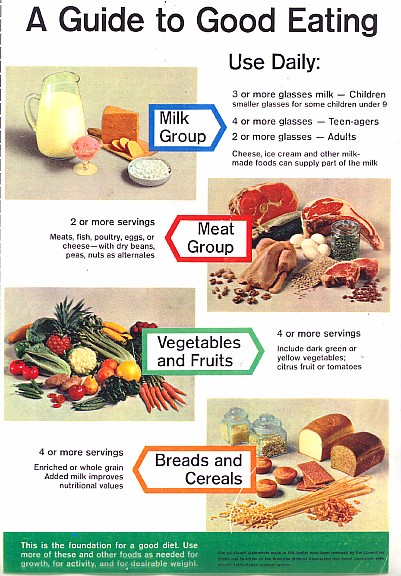   http://www.mypyramid.gov
(Click on the left on "Inside the Pyramid".)
|
||||||||||||
Portion Distortion: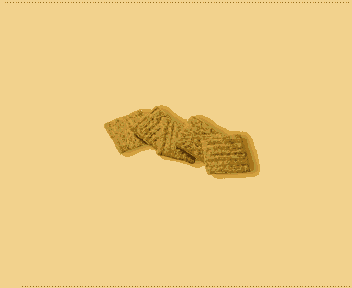 The measurement of that ounce of dry weight varies. You can see in the above image that an ounce of triscuit crackers is about 5 of them. An ounce is equal to about 30 grams. Dry cereal usually gives the gram weight and the cup measurement.
There is now considerable "portion distortion" in what we think of a serving, as illustrated below. |
||||||||||||
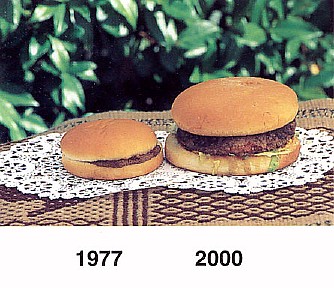 |
||||||||||||
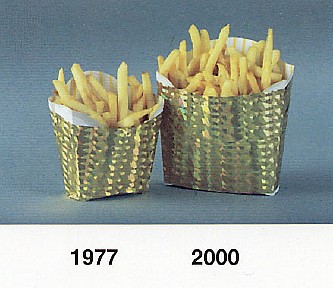 |
||||||||||||
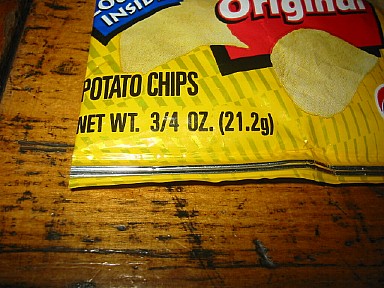 |
||||||||||||
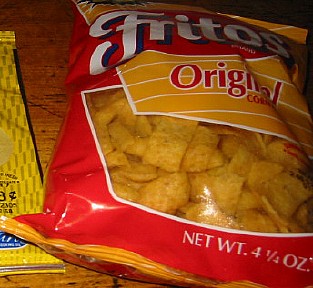 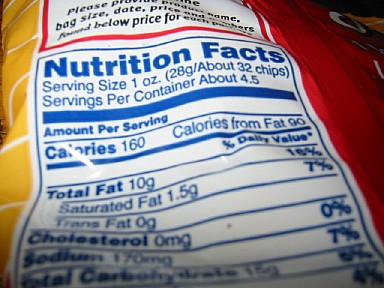 4 1/4 oz. Bag Fritos: 4.5 servings per container The Nutrition Facts
are given for 1
serving.
Do you see where the label says Calories 160 160 calories times 4.5 servings per container= 720 calories/bag |
||||||||||||
 If you're trying to
cut down your portion sizes, one way to do it is to
use smaller plates. These are each one-cup portions
of spaghetti.
The below video is research conducted by Brian Wainsink that demonstrates this concept Controlling Calories: The Discretionary Calorie Allowance The food guide pyramid really is encouraging people to take a balanced approach and to eat a variety of nutrient dense whole foods. To help people control calories and prevent weight gain, the USDA developed the concept of discretionary calorie allowance.
As the figure above demonstrates, a person needing a 2,000 calorie diet may need only 1,700 calories of nutrient dense foods to get their needed nutrients. The difference between calories needed to maintain weight and calories needed to provide needed nutrients (about 300 calories) would be discretionary calories, or calories that can be spent on extras like added fats, added sugars, or extra servings of nutrient dense foods. When choosing your food selections from the different food groups, most of your choices should be nutrient dense in order to meet your calorie requirement. For example when choosing dairy products they should be non-fat dairy products with no added sugar, like non-fat milk. If instead you chose strawberry flavored, whole milk you would be using discretionary calories due to the fat content and the added sugar. In general the most nutrient dense food choices from the food groups are foods that are minimally processed and do not have added fats or sugars. Fresh fruits and vegetables, whole grains, non-fat dairy, and lean meats, beans and nuts. Examples of foods with discretionary calories would be:
Can you think of how discretionary calories might actually help you to eat nutrient dense foods? I don't know about you, but I love putting butter or olive oil on my cooked vegetables, or honey on my whole grain toast or oatmeal. Adding a little fat and sugar sometimes can enhance the flavor of nutrient dense foods. This is a great way to spend discretionary calories. They will come packaged with other nutrients, unlike drinking a soda packed with calories and no other nutrients. |
| III Daily
Values (DV) (page Y in back of book) Definition- A set of suggested daily intakes of calories and selected nutrients, developed to use on food labels. They don't vary by age or gender; they are usually the highest RDA for that nutrient. Reflect the needs of an “average†person (someone eating 2,000 calories a day). Based on the 1968 RDA; are not updated on a regular basis. Look on page Y in back of book to fill these in. Iron DV ________________ Calcium DV ______________ Click here if page Y says the iron DV is 15 mg. Click here if page Y says the iron DV is 18 mg. Click here if page Y says the calcium DV is 800 mg. Click here if page Y says the calcium DV is 700 mg. 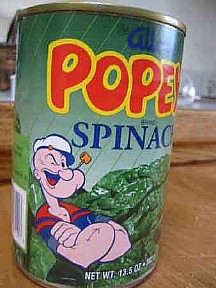 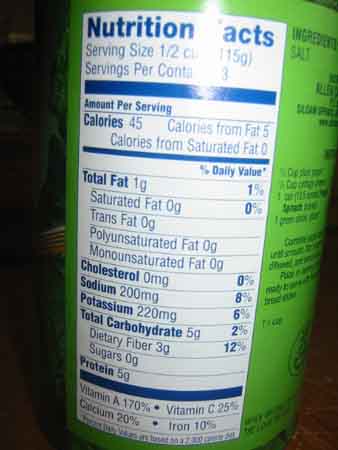 A DV on a food label lists what % of the DV a serving _ of the food supplies. MAGIC DV- we are going to say that the “magic†% Daily Value is 10%. In other words, we will consider a food a "good source" of a nutrient if the label says a serving of it has 10% or greater of the DV(Daily Value) for that nutrient. Using this definition and looking at the spinach label above , what nutrients should we consider the spinach a "good source" of? Click here if, using
this definition, we should consider this spinach a
"good source" of Sodium.
Click here if, using this definition, we should consider this spinach a "good source" of Total Carbohydrate. Click here if, using this definition, we should consider this spinach a "good source" of Dietary Fiber. Click here if, using this definition, we should consider this spinach a "good source" of Vitamin A. Click here if, using this definition, we should consider this spinach a "good source" of Vitamin C. Click here if, using this definition, we should consider this spinach a "good source" of Calcium. Click here if, using this definition, we should consider this spinach a "good source" of Iron. |
IV Dietary
Guidelines for Americans, 2005 (Ch. 1, p. 16 of
text)
2010 Dietary Guidelines for Americans A few of the new guidelines in the 2010 report include: I think it is great that these guidelines don't only address the individual, but also the food industry. It will be interesting to watch how these guidelines influence food manufactures and nutrition policy. We will be discussing the Dietary Guidelines throughout the term so I'm not going to say a whole lot about them here. |
| V
Beyond the nutrients
of the twentieth century Definition- chemicals
that plants make to help them survive and get ready to
reproduce. Phytochemicals help them do that by helping
Lycopene is an
example of a phytochemical and food companies are
anxious to use them to market their products.
 It is estimated that
there may be more than 100 different phytochemicals in
just one serving of vegetables.
In her book, Animal, Vegetable, Miracle: A Year of Food Life, Barbara Kingsolver says that a head of broccoli contains more than a thousand phytochemicals. (page 60) Some companies
selling supplements imply theirs is better than others
because it has "whole food". Nutrition Action,
in December 2007, said that once dehydrated, a serving
of fruit or vegetable (1/2 cup broccoli, for example)
would fill some 15 capsules. ("Juice Plus Commission")
B. Zoochemicals are the same thing in animals. C. Neutraceuticals- (term first used in 1989)- a term that
motivates companies to divide food into individual
chemicals that may have medical or health benefits,
including the prevention and treatment of
disease. These neutraceuticals are then sold
at a much greater profit than what a farmer makes
when selling a whole food.
Example: Benecol
margarine
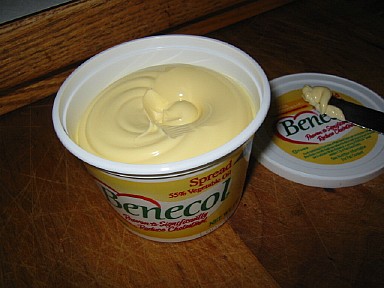 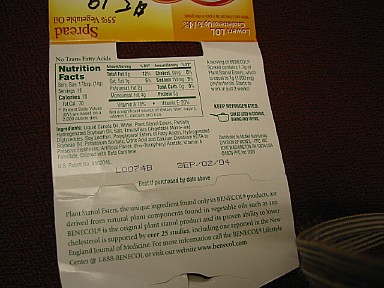 The label says that
“Plant stanol esters, the unique ingredient found
only in Benecol products, are derived from natural
plant components found in vegetable oils such as
soy.
….its proven ability to lower cholesterol is supported by over 25 studies, including one reported in the New England Journal of Medicine.” I purchased this 1-cup tub of margarine so I could take a photo of it. I eat butter because I love it's flavor and I'm very satisfied with just a little of it at a time. So I gave this tub to a friend who uses margarine. They returned it because they didn't like it. Look at the price for this this 1-cup tub (2006). 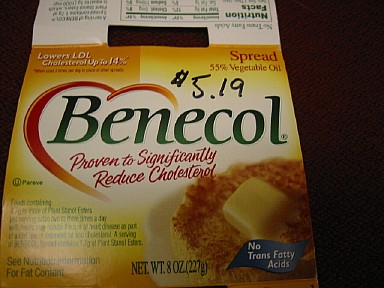 The Benecol implies that their plant stanols come from vegetable oils like soy, saying that they "are derived from natural plant components found in vegetable oils such as soy." Plant stanols are also found in wood pulp. C. The best way to get phytochemicals is by choosing a variety of whole plant foods, such as fruits and vegetables and whole grains. I can't remember where I read or heard Michael Pollan (a contributing writer to the New York Times Magazine and a professor of journalism at the University of California, Berkeley) talking about this. He said that for quite a while we've been encouraged by companies to buy their 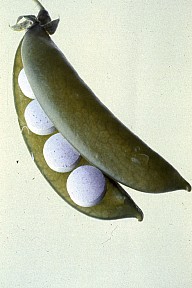 Now we're being encouraged by companies to buy their "pill in a meal".
The end of Lecture 2A |
